 Brian Dennis emerged from the poison oak-lined path and waded across the shallow creek mouth. “What a small world,” I thought to myself as Brian introduced himself and I folded up the Naish Triad kite I had just finished testing. Brian Dennis is the head kite designer at Naish Kiteboarding, and while he’s based out of Maui, by way of many years in Hood River, Brian is no stranger to the unnamed beaches of Santa Cruz’s north coast. With his laid-back but animated excitement for kiteboarding, Brian’s long hair and constant five-day shadow belie his technical confidence and fierce obsession with the small engineering details that permeate every aspect of Naish’s new equipment. Brian has the scholarly precision required of a kite designer, quietly assessing the field, the players and the obstacles, yet his demeanor is down-to-earth, such that he could quite possibly, and oftentimes does, pass for the run-of-the-mill wind addict lining up the set wave in front of you.
Brian Dennis emerged from the poison oak-lined path and waded across the shallow creek mouth. “What a small world,” I thought to myself as Brian introduced himself and I folded up the Naish Triad kite I had just finished testing. Brian Dennis is the head kite designer at Naish Kiteboarding, and while he’s based out of Maui, by way of many years in Hood River, Brian is no stranger to the unnamed beaches of Santa Cruz’s north coast. With his laid-back but animated excitement for kiteboarding, Brian’s long hair and constant five-day shadow belie his technical confidence and fierce obsession with the small engineering details that permeate every aspect of Naish’s new equipment. Brian has the scholarly precision required of a kite designer, quietly assessing the field, the players and the obstacles, yet his demeanor is down-to-earth, such that he could quite possibly, and oftentimes does, pass for the run-of-the-mill wind addict lining up the set wave in front of you.
Later that day, with two sessions under his belt, Brian spotted an orange kite down on the cold, windswept horizon. From the looks of things, his first thought framed a helpless beginner, deep within the Red Triangle, stranded far from the herd, but upon investigation, he found a longtime Santa Cruz local (think founder of a flying car company) self-rescuing with about a half-mile left on the odometer to safety.
After assisting with the rescue, back on the beach, Brian learned that the quick release in question had accidentally triggered at the worst moment conceivable and reassembly was not possible. Conveniently, Brian began to show off Naish’s new SnapLock quick release design and proudly demonstrated how its ergonomics prevents unintentional releases and, more importantly, how the seat belt-style mechanism reconnects easily with one hand””even when you are swimming over deep, shark-infested waters. It’s safe to assume that the kind of person that builds flying cars knows a good technical solution when he sees one, and after studying the Naish quick release with great interest, he asked Brian if he ”˜knew a guy’ who could get him one.
A few months later, I reconnected with Brian to talk about his rise to designer fame, the Naish R&D process and the evolution of the one quick release design that offers a true one-handed reset…

You seem to do a little bit of everything from kiteboarding to snowkiting and now wingsurfing. What was your background before your time at Naish and how did you land one of the top jobs in the industry?
My background has always been in engineering. I started my career in the snowboard industry designing boots, working with factories in Korea and China with a focus on material development and manufacturing methods””that work was probably the most relevant work to what I do now. Over the years, I had tried to find an opportunity at Naish, but the timing was never right. I had been living in the Gorge and was working in the UAV (unmanned aerial vehicle) industry, dealing with composites, patterning, layups and molds when Naish put the word out that they were looking for an engineer. They wanted to redesign their control bar and modify their hydrofoil hardware, and I signed up immediately. Just as I began working on a new foil mast and a beginner kite foil wing, their previous kite designer left””that opened up an opportunity to shift into kite design.
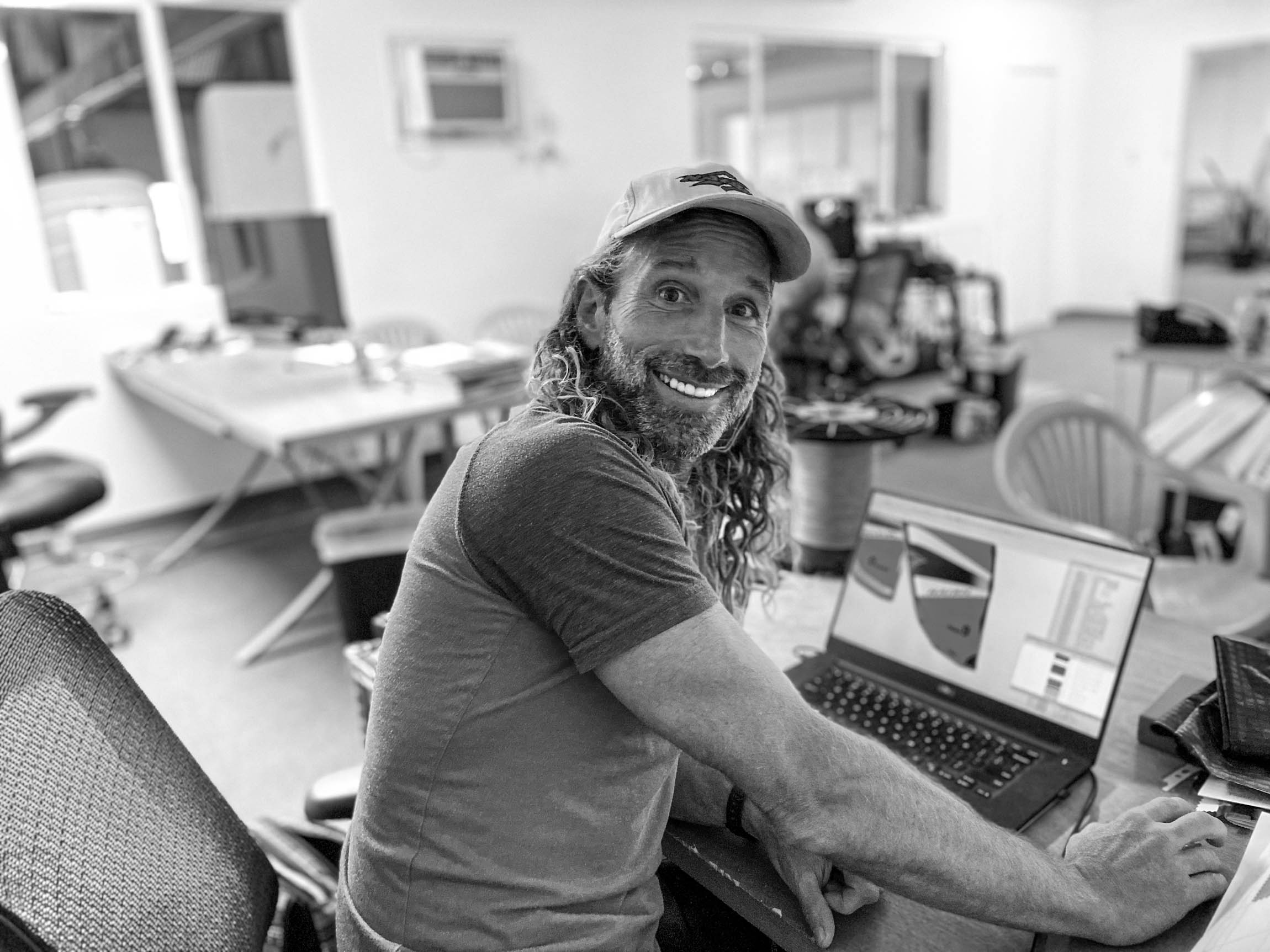
Brian Dennis at work surrounded by the essentials: a laptop, a spool of line and in the background, a 3D printer station. // Photo Jennica Lowell
Naish is one of those iconic workplaces in the kiteboarding industry that mixes laid-back water culture with high-pressure performance expectations. What’s it like interviewing for a job in the hot seat of innovation?
Probably the biggest question during my Naish interview was whether the company and I matched in terms of personality. It seemed to me like I was meeting likeminded people that loved to be in the water all the time, having fun while being creative with it. They had this project on their list that wasn’t getting done””they wanted to design an extra-large size in the twin tip binding and asked me if I could do it. I said sure; I could knock it out because I had a laptop and the right software. It ended up being a surfaceheavy modeling job, and I stayed up all night to get it done, then handed it back to them the next day. They said, “Good, glad you can get it done so fast,” and that was the beginning of my career at Naish. It’s actually quite funny””all my work life, I’d be the guy slinking out the back door, and people would always be asking me where I was yesterday. There are only so many good excuses out there, but now I love every aspect of the work I’m doing, and this is the first time that people have to pry me away from my computer and remind me when it’s time to go to the beach.
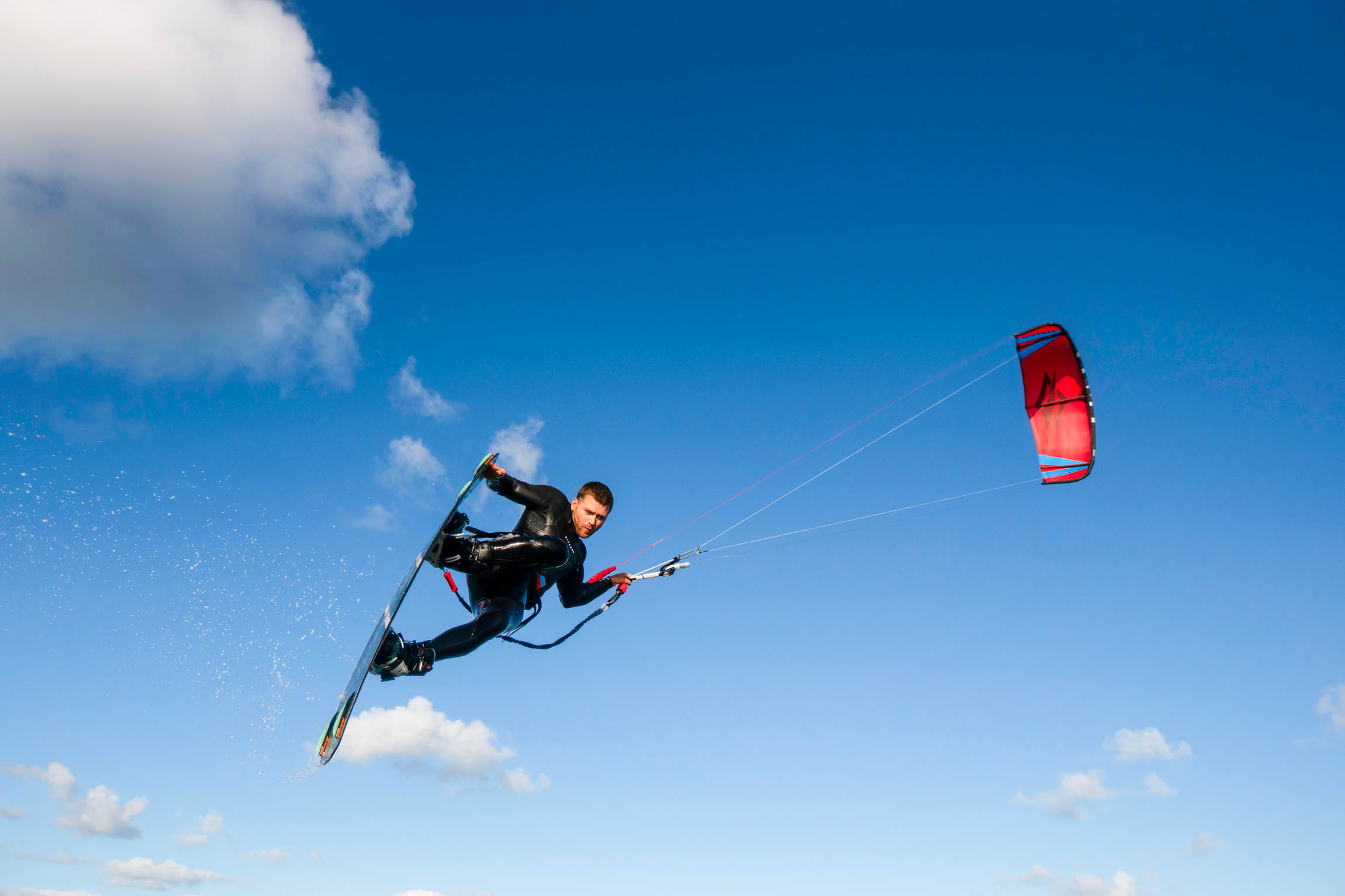
Ewan Jaspan bones out a stylish nose grab on Naish’s streamlined S26 Dash kite. // Photo Ben Savage
What’s the biggest difference between your UAV work in the Gorge and building windsports products in Maui?
When I lived in Hood River, I loved to travel and I’d go on a ton of kite trips, especially in the winter. Now that I live on Maui, I have good conditions right out the front door and I don’t feel like I have to travel so much. The other part is how meaningful it is to build good products. At Naish, I feel like I’m doing some good in the world. I often think about the fifty or more of my kite friends in the Gorge as my guiding principle. I ask myself what would ”˜so and so’ think of this product. A lot of the conversations with my friends tend to end up as mental notes; it might be a complaint or something like a wishlist, but much of this informal dialogue ends up steering our goals. All the people I’ve met along the way, friends old and new, these are the people we serve; they’re kind of like the designer’s social conscience.
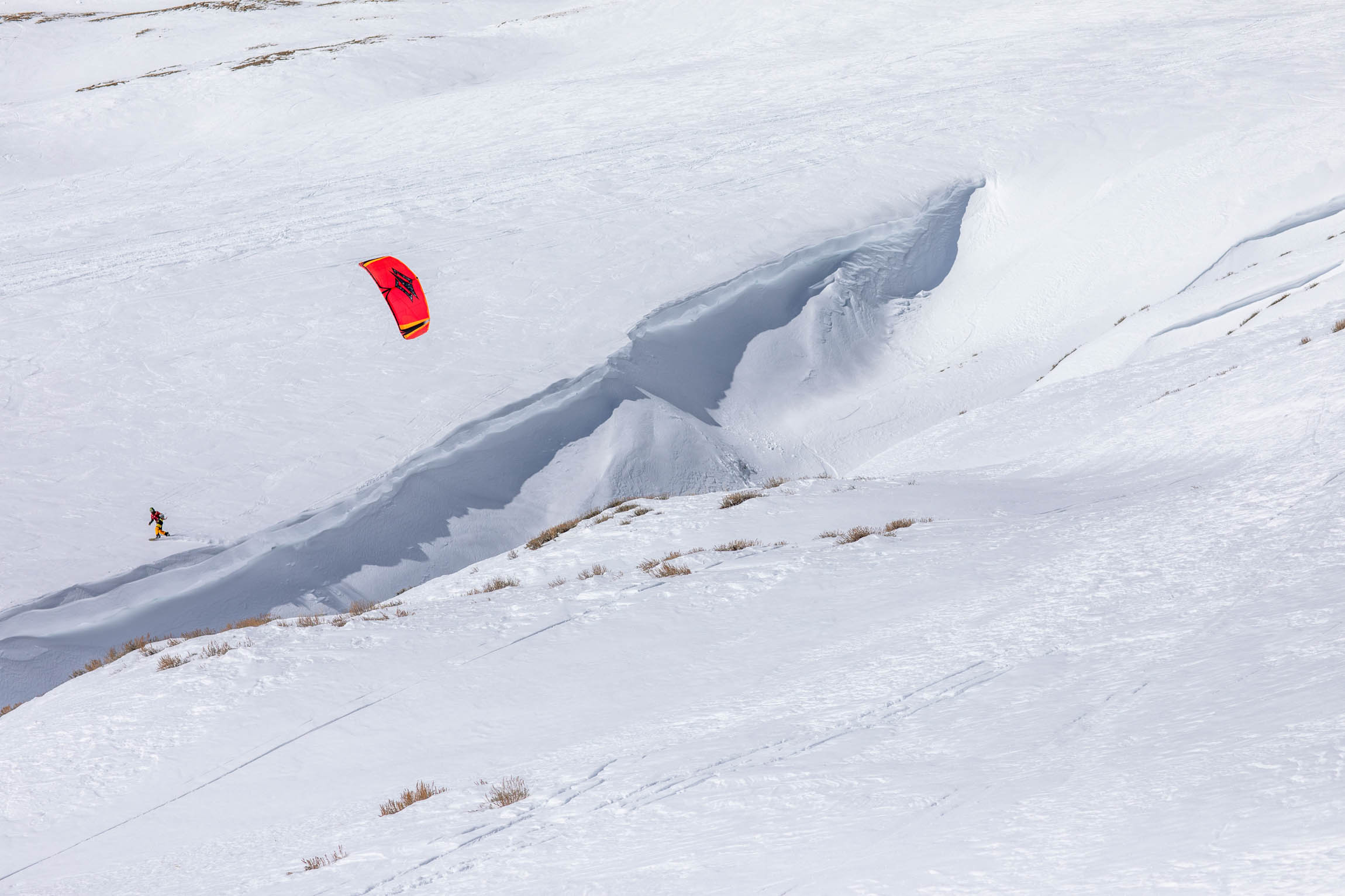
Brian skirts a crevasse, reinforcing the argument that the Triad will take you just about anywhere. // Photo Seth Warren
For the individual having just survived a mile-long swim of shame, the new Torque 2 bar with the SnapLock release has got to be intriguing. What was the inspiration and the process behind developing the new bar technology?
We knew we wanted to design a new quick release because we had been using the same mechanism for five years. We also knew a quick release could be easier to use and seamless with the new style of seat belt mechanism that had recently come out. Both of those things go hand in hand with safety and reliability, and those were our biggest design goals. If you’ve ever tried to coach someone through reassembling a standard quick release, it always takes two hands, and they don’t always get it in real-world conditions. Taking a step back, the seat belt mechanism makes the reconnection process easier because you don’t have to hold or cock the quick release handle, but the dexterity it takes to close the open-loop designs that are the most common on the market are still very much a two-handed process. This is why we turned to a closed-loop system that remains connected to your harness. With the chicken loop fixed to your harness, you can guide the quick release to your chicken loop with one hand and make that connection. Sure, two hands make it even easier, but one hand will get the job done.
After a high-profile incident with a video on the internet highlighting how another brand’s quick release was accidentally tripped in the middle of a big air, we knew there was room for improvements in the industry. We specifically designed our handle to prevent this kind of situation from occurring. The time kiters spend on land, near hard objects and boosting big airs is crucial in terms of kite control, and the accidental release is a danger that always needs to be addressed.
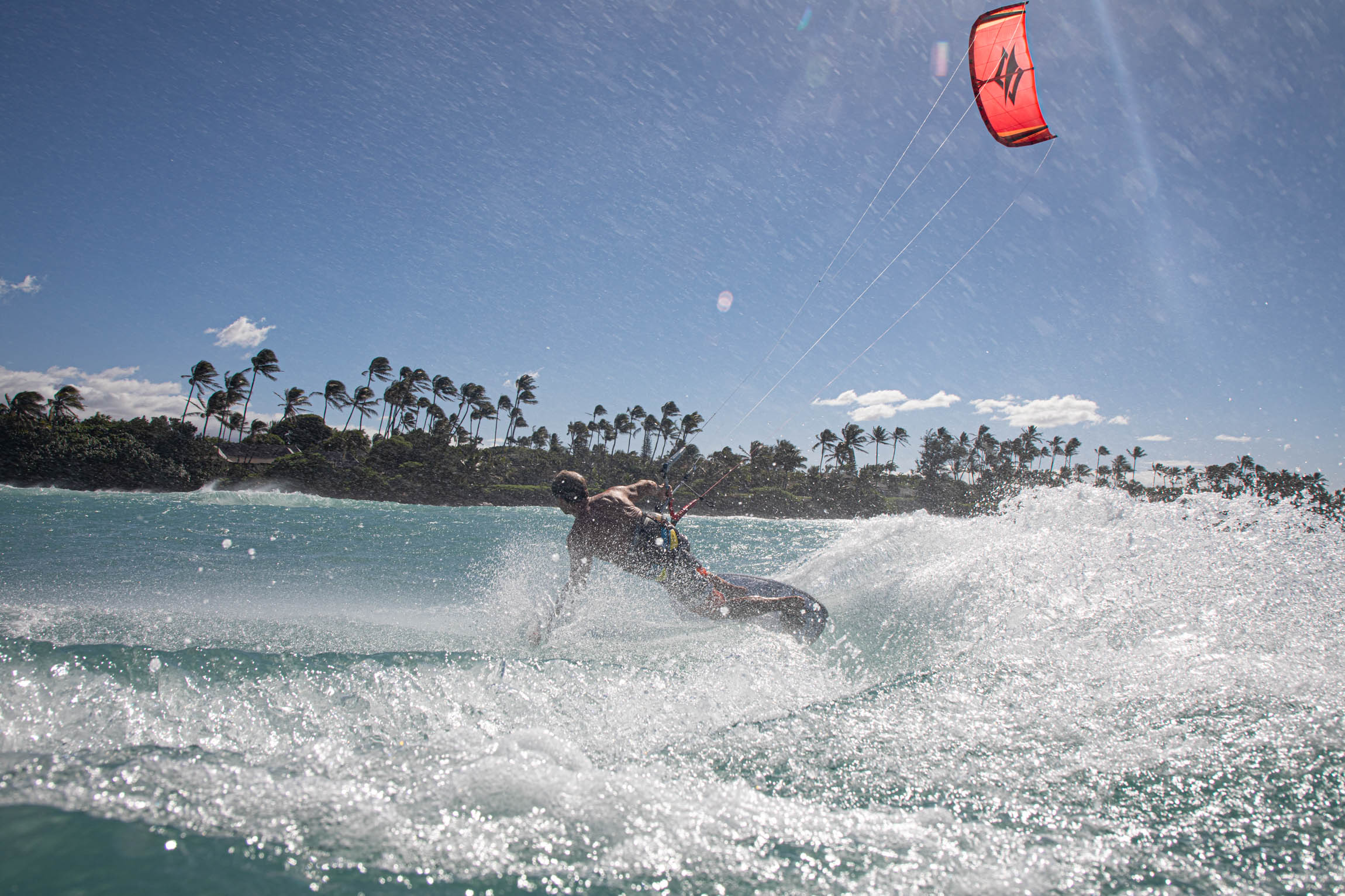
The Boss of kite bosses, Robby Naish proves the all-terrain carving capabilities of the Triad and his new carbon Global. // Photo Frankie Bees
What was the R&D process like for coming up with a completely new quick release design?
The seat belt concept was on everyone’s minds here at Naish, and for us, the closest analogy was how the compressor in the shop uses air hoses with interchangeable fittings that operate with a sliding collar and a simple but mechanical click-toreengage design. We ended up cutting one of those air hose fittings in half to play around with the idea, and while it was an interesting exercise, it became clear that the existing design’s use of ball bearings wouldn’t stand up to the challenges of sand, saltwater and corrosion that a quick release typically encounters. We took the concept and started to come up with similar designs on our computers and then used the plastic 3D printer in the office to mock up and visualize all of the parts. Following that with 3D metal printed parts, we were able to test a working prototype on the water within a month of the initial concept, which is a really fast turnaround for getting a rough working model. Once we were convinced that the design had merit, we started bench testing. Kiteboarding now has ISO standards for quick releases, and that defines what ”˜strong enough’ truly means. The first test focuses on the strength of the quick release, and the second part of the ISO certification tests the device’s ability to trigger while under extreme loads. Say the kite is spiraling out of control and you’re half underwater with massive pulling power loaded into your safety system. We have to make sure the quick release triggers just as easily when you’re in that situation as when you’re on the beach with no load. After completing the ISO certification, you’ve got to move towards production, lining up suppliers, materials and surface finishes””there are a million details to get right and then once you’ve reached actual production, you’ve got to have well-monitored quality control measures in place.
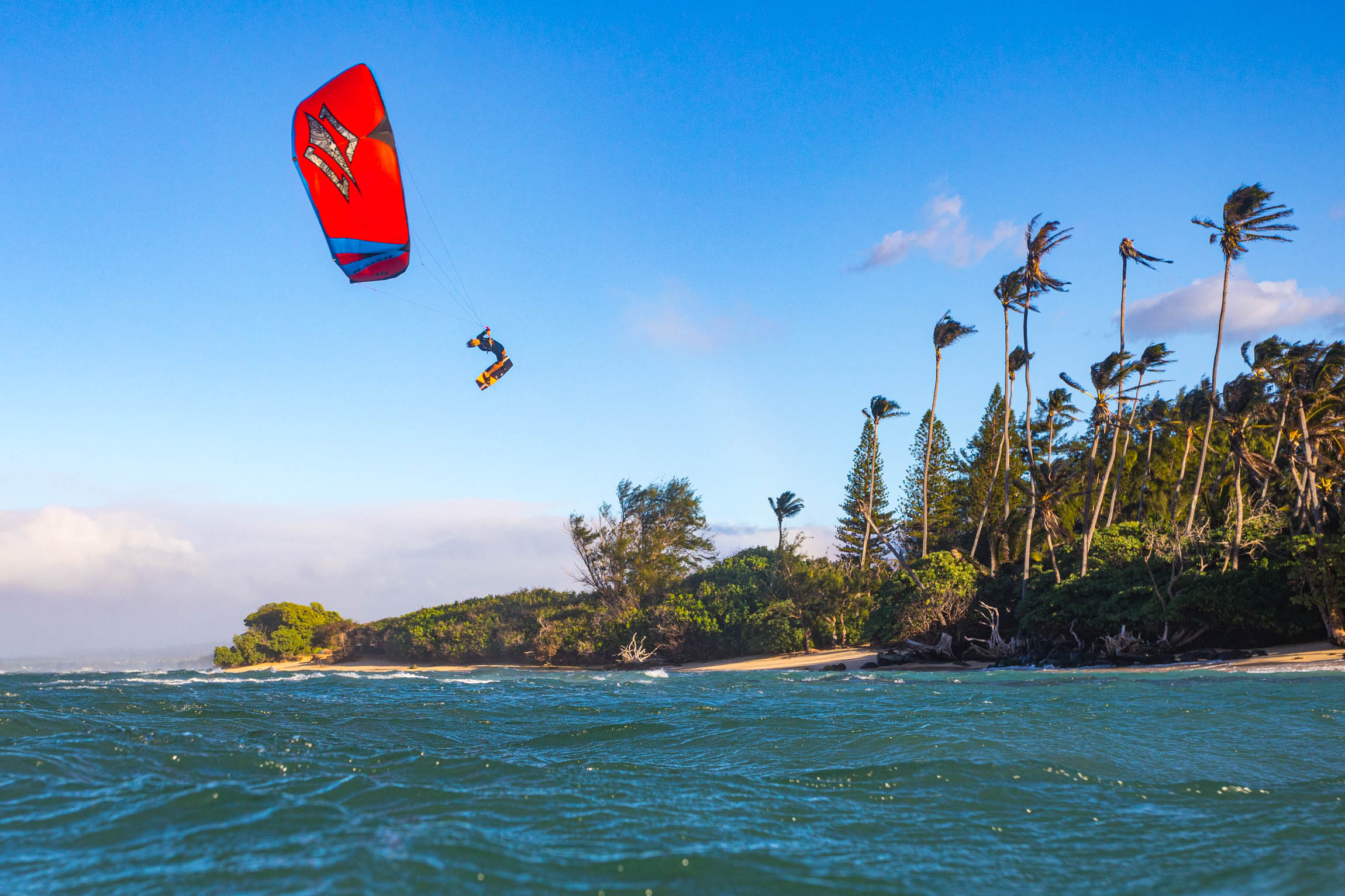
Tailored for big moves, Vetea Boersma throws a mammoth kite loop taking technical advantage of shorter and thicker line sets. // Photo Frankie Bees
The Torque 2 has several other innovative changes that redefine the user’s experience, like the new Micro Loop with the L-shaped chicken finger. What are the features that are most important to you?
We had a list of things that people wanted to see with the new bars beyond the basics of making the release low profile to prevent accidental releases and ergonomically easy to grab when you need it. We wanted to make the quick release compact which brings the bar’s throw closer to your body so that the bar has a better fit for all riders, especially those with shorter arms. Part of that is designing the quick release body but also creating a smaller loop that brings everything closer to you. There are four different loops to fit different riding styles, but for most riders out there, the Micro Loop will be the best option. The Micro Loop’s design integrates a new L-shaped chicken finger; internally, we like to call this guy ”˜Mr. Happy.’ This new finger lock gives you an incredibly secure connection between the quick release and your harness bar. However, we learned through the R&D process that it doesn’t work right on the bigger loops, so you’ll only find the L-shaped chicken finger on the Micro Loop.
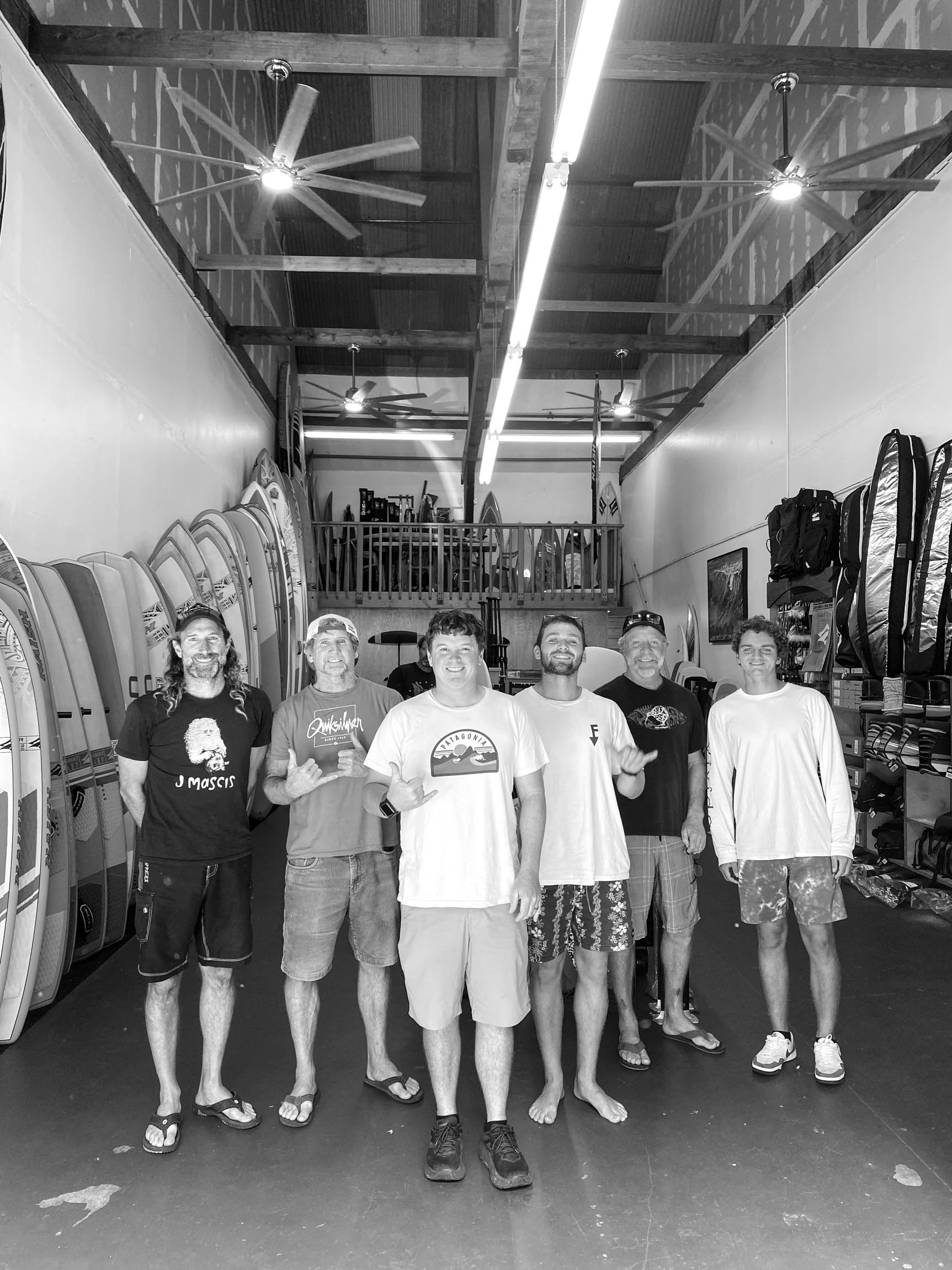
The crew that makes things tick at Naish headquarters. Left to right: Brian Dennis, Robby Naish, Jeff Urfer, Ewan Jaspan, Des Walsh and Tom Seager. // Photo Jennica Lowell
There are other subtle changes that we’ve made that might get by the average user. For instance, our professional athletes obsess over line length, thickness and stretch qualities, yet there seems to be a lot of misinformation, or maybe more accurately, misdirection, that puts all the attention on strength as the key quality. Fixating on line strength is pretty much a waste of time because all kite lines end up much stronger than they need to be. If each line can handle 1000lbs, and you spread that across four lines, then you’ve got lines that could theoretically suspend a 4000lb car in the air. That’s overkill.
We’ve put a lot more energy into studying other qualities like stiffness, which affects the feel of how you’re connected to your kite. Basically, all lines behave somewhat like a rubber band. Thicker lines have less stretch, yet they add more wind resistance which results in more bow between the bar and kite. You could go super thin and get more line stretch but minimize the resistance and the bow. Depending on which way you go, you can end up in roughly the same place concerning the feel of stretchiness. It’s a complicated debate that affects all manners of kite performance, but there doesn’t seem to be one obvious answer. Disciplines like big air or freestyle may go with thicker lines, while lower load and more efficiency-oriented riders like hydrofoilers, freeriders and surfers will want thinner line sets. For the moment, our Torque 2 bar comes with a thinner line set that suits most riders, and for top-end riders, there’s a stiffer line set available as an accessory option. Since most users want variable-length lines, our bars come in 24m lengths with 22m and 2m extensions, but extensions have historically added windage and friction. We’ve removed the sleeving at the extension junction, and some of our riders have questioned this from a durability standpoint. Since sleeves put extra needle holes in the lines and lower the strength while adding friction, instead, we’ve opted to increase performance and strength. We can nerd out endlessly on these details, but all these design decisions affect performance and feel, and that’s where we are making some bigger changes.
Having inherited an impressive range of kite models, what’s your approach going forward as the market changes with evolving disciplines and new equipment trends?
If you look at the history of Naish’s kites and step back to assess where we are now, we have six different kite models; each one is marketed as a specialty design, but they all work really well for the average consumer, with the single exception of the 5-line Torch which is very specific to freestyle. There’s been this convergence of design where the innovations in bridle layout and 3-strut design have narrowed the differences between these specialist platforms. If you look at what most people are doing, maybe 75% are mowing the freeride lawn, while some people are obsessed with big jumps and others only care about waves. Regardless, few kiters are mixing their quiver between the purpose-built products. Basically, riders are buying the kite that targets their interest, yet banking on enough userfriendly handling to allow them to cross over into another range of conditions or discipline of riding.
In terms of specific model evolution, recently, we’ve put a lot of energy into building the ultimate big air kite that allows you to sheet in and hang on, which is targeted for those that just want to pursue big, lofty airs. The Triad, which is our entry-level kite, has turned out to be a surprisingly fun jumping kite and is really good in the drift department, so now more people are choosing that for surf. With the categories kind of nailed down and the design momentum focused on tweaking and fine-tuning, we are paying a lot of attention to innovation in materials and making our existing platforms even lighter. While lighter materials are key for performance, we never push that at the expense of durability. For the customer setting out on his or her big kiteboarding trip of the year, if the product fails and they can’t go kiting on day two, that’s not acceptable. Part of my job is studying the warranty claims that get filed all around the world. Long after we’ve tested and released the products, we’re constantly looking at what breaks and why.
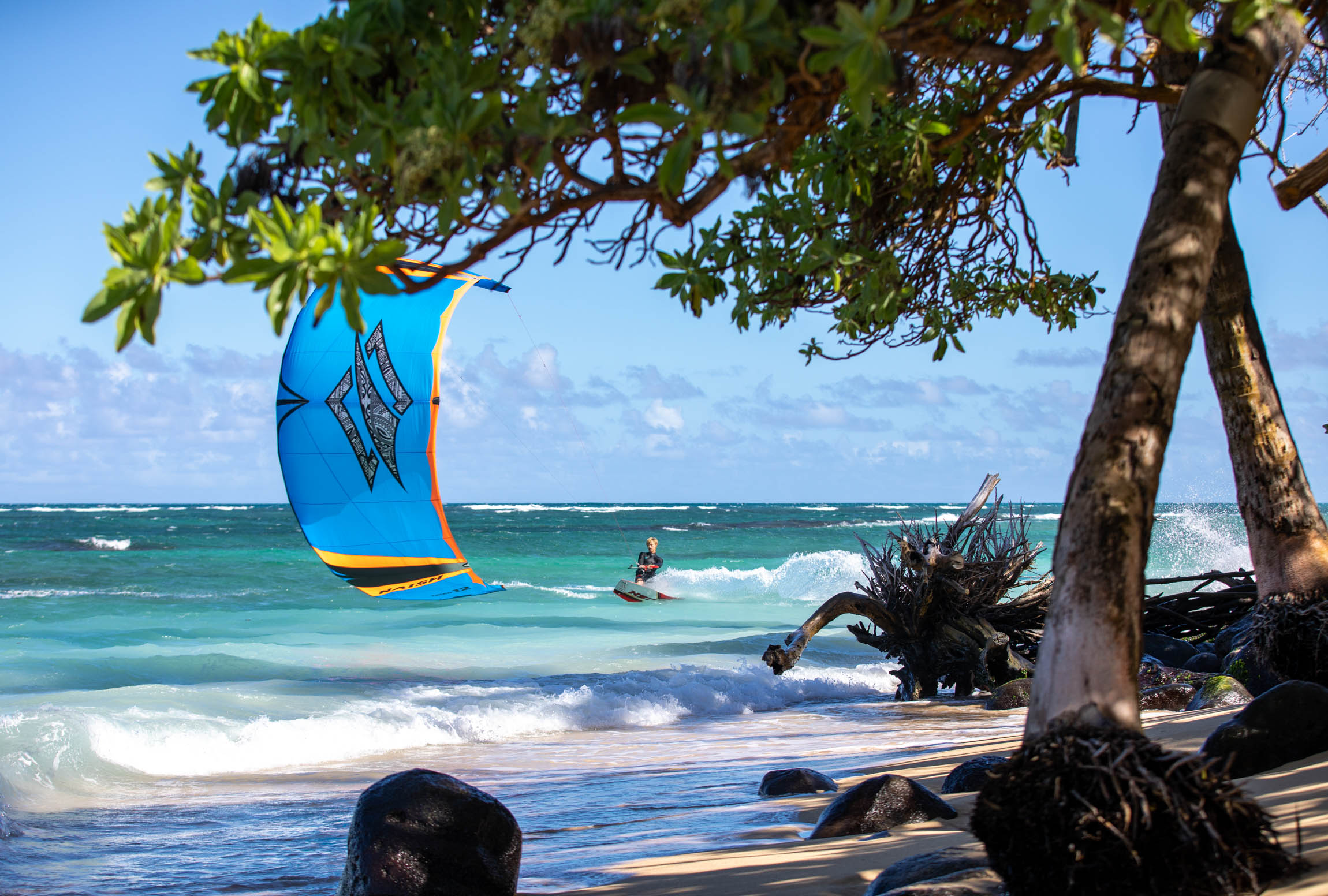
Vetea Boersma framed by the classic Maui setup: trades on the horizon, offshore reefs and colorful kites with Naish logos. // Photo Frankie Bees
With two years in the trenches of the Naish R&D department, what’s the biggest lesson learned so far in your kiteboarding design career?
We spend a lot of time on the water here at Naish, and it’s not just me. The biggest lesson I’ve learned is that there is no substitute for back-to-back testing and using a lot of different testers. You have to spend your time at the beach, testing multiple days with different conditions and swap kites over and over again so that you can remove the subjectivity in the process. We rely on feedback from a big group of riders that spans every level from beginners to pros””you always have to keep your eyes open for data points and be able to observe through multiple lenses.
 This article was featured in our summer 2021 issue, Vol. 18, No. 2. To read more, click here.
This article was featured in our summer 2021 issue, Vol. 18, No. 2. To read more, click here.


